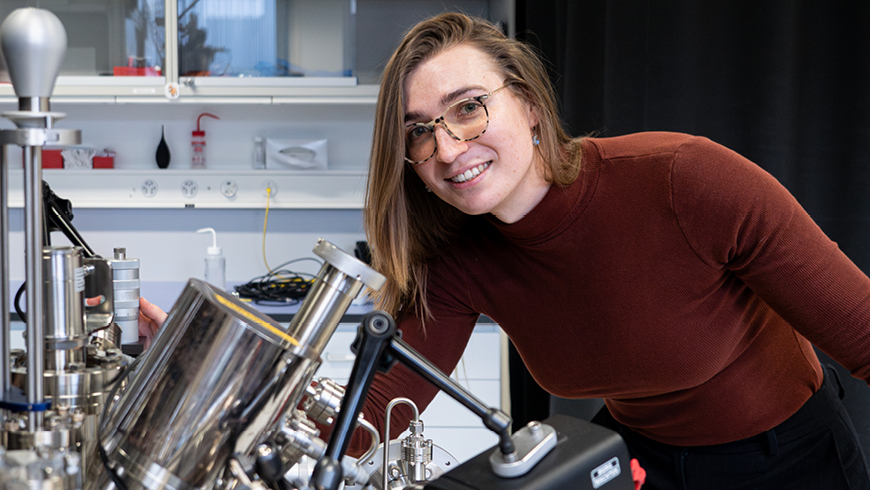Empa Young Scientist Fellowship
Young researcher sheds light on quantum molecules
Empa researcher Eve Ammerman wants to bring quantum technologies one step closer to application by combining quantum effects with light. This should enable future quantum-based devices to communicate better with existing technologies. Her research project is being supported with a two-year Empa Young Scientist Fellowship.

Quantum technologies are extremely promising for tackling computationally complex problems in the areas of fundamental science, medicine, and communication. However, they still need to become much more robust before they can be widely implemented alongside existing technologies. This is because quantum effects of many kinds become particularly noticeable at nanometer scales. Quantum researchers therefore often work with individual molecules in order to observe quantum phenomena in isolation. A particularly promising route is using custom-made "designer" molecules. However, working with such tiny structures is anything but easy, as Empa researcher Eve Ammerman knows.
The physicist has been working in Empa's nanotech@surfaces laboratory led by Roman Fasel for two years. The laboratory is a pioneer in the production and use of nanographenes. These nanometer-sized pieces of the two-dimensional carbon material graphene have pronounced quantum-physical properties, which can be controlled by altering the shape of the molecule. Ammerman is interested in nanographene molecules that have a so-called spin. Spin, a quantum form of magnetism, is considered to be of particular interest for quantum technologies. It could potentially be used to create a qubit, the fundamental unit of information of a quantum computer. However, the spin alone is not enough for a practical application: In order to interact with these magnetic nanographenes, the researchers must link them to other components, for instance those that provide input and output.
Communicating via light
But how do you “wire up” a piece of graphene just one nanometer in size? “This tiny molecule, which comprises just a few dozen carbon atoms, must not be damaged in the process,” says Ammerman. There is also another risk: Interactions with the environment can disrupt the fragile quantum states in nanographene. Ammerman is therefore taking a different approach in her project. She wants to shed some light on the spin-carrying molecule – literally. To do this, she is aiming to combine the nanographene molecules with a so-called chromophore: a molecule that can emit light. If the spin of the nanographene changes, the light of the chromophore also changes. The advantage: Light can be measured without physical contact. The researcher has recently been awarded a two-year Empa Young Scientist Fellowship for her project.
Ammerman anticipates a number of challenges. How do you link the two molecules so that they “talk” to each other without getting in each other's way? Which molecular structures will work best? And how do you measure the results? “Although there is already a lot of research on both nanographenes and light-emitting molecules, we have hardly any data on what happens when you combine them,” she explains. Over the next two years, she wants to fill this gap – and develop a molecular duo that can be processed into functional quantum mechanical devices, which could help link future quantum systems and existing fiber optics technology. “Working at the interface between the fundamentals and potential applications really fascinates me,” says the researcher.
Talent promotion at Empa
The Empa Young Scientist Fellowship is a funding program for exceptionally talented young scientists. Fellows receive funding to carry out an independent research project for a period of two years. Fellowships are awarded in a competitive process to select the most promising projects.
-
Share






